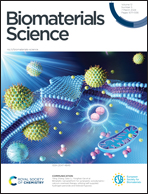Aggregation-induced emission photosensitizer microneedles for enhanced melanoma photodynamic therapy†
Abstract
The incidence and mortality rates of skin melanoma have been increasing annually. Photodynamic therapy (PDT) enables effective destruction of tumor cells while minimizing harm to normal cells. However, traditional photosensitizers (PSs) suffer from photobleaching, photodegradation and the aggregation-caused quenching (ACQ) effect, and it is challenging for light to reach the deep layers of the skin to maximize the efficacy of PSs. Herein, we developed dissolving microneedles (MNs) loaded with PSs of TPE-EPy@CB[7] through supramolecular assembly. The PSs effectively enhanced the type-I reactive oxygen species (ROS) generation capacity, with a concentration of 2 μM possessing nearly half of the tumor cell-killing ability under 10 min white light irradiation. The MNs were successfully pierced into the targeted site for precise drug delivery. Additionally, the conical structure of the MNs, as well as the lens-like structure after dissolution, facilitated the transmission of light in the subcutaneous tissue, achieving significant inhibition of tumor growth with a tumor suppression rate of 97.8% and no systemic toxicity or side effects in melanoma mice. The results demonstrated the potent melanoma inhibition and biosafety of this treatment approach, exhibiting a new and promising strategy to conquer malignant melanoma.

- This article is part of the themed collection: Biomaterials Science Recent HOT Articles


 Please wait while we load your content...
Please wait while we load your content...